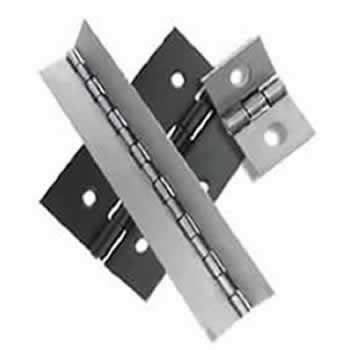Hinges
Hinges are ingenious mechanical components that enable the smooth movement and rotation of doors, cabinets, gates, and various other objects. They provide a pivot point, allowing two surfaces to open, close, or swing in a controlled manner. Hinges are integral to everyday life, found in homes, offices, vehicles, and industrial applications. From simple butt hinges to sophisticated concealed hinges, they come in a wide variety of designs, materials, and sizes, catering to diverse requirements. In this comprehensive product description, we will explore the world of hinges, their types, materials, applications, and the indispensable value they bring to countless projects and everyday use.
What are Hinges?
Hinges are mechanical devices that connect two objects and allow them to pivot or rotate relative to each other. They consist of two leaves or flaps joined by a pin or rod, which acts as the pivot point. Hinges provide a range of motion, such as opening and closing, swinging, or folding, depending on the hinge type and application.
Types of Hinges
Hinges come in various types, each designed for specific applications and movement requirements. Some common types include:
- Butt Hinges: Butt hinges are the most common type of hinge, consisting of two rectangular leaves connected by a pin. They are used for doors, cabinets, and various furniture applications.
- Continuous Hinges: Continuous hinges, also known as piano hinges, run along the entire length of the connected objects. They offer continuous support and are commonly used for lids, panels, and doors.
- Concealed Hinges: Concealed hinges are hidden from view when the door or cabinet is closed, providing a clean and streamlined appearance. They are often used in high-end furniture and cabinetry.
- European Hinges: European hinges are commonly used in modern cabinetry and provide easy adjustment for door alignment.
- Ball Bearing Hinges: Ball bearing hinges contain ball bearings between the hinge leaves, offering smooth and quiet movement. They are ideal for heavy doors and gates.
- Spring Hinges: Spring hinges have a built-in spring that automatically closes the door or gate when not held open.
- Overlay Hinges: Overlay hinges are used for doors that overlay the frame or cabinet, providing a clean and seamless look.
- Offset Hinges: Offset hinges allow the door or panel to swing away from the frame or cabinet, making them suitable for unique installations.
Materials for Hinges
Hinges are available in various materials, each chosen based on factors such as load-bearing capacity, environmental conditions, and aesthetics. Common materials include:
- Steel: Steel hinges are durable and widely used in both residential and industrial applications.
- Stainless Steel: Stainless steel hinges offer excellent corrosion resistance and are ideal for outdoor use and marine applications.
- Brass: Brass hinges provide an aesthetically pleasing finish and are often used in decorative and antique-style furniture.
- Aluminum: Aluminum hinges are lightweight and corrosion-resistant, making them suitable for aerospace and marine applications.
- Plastic: Plastic hinges are used in lightweight applications, such as small cabinets and boxes.
- Chrome: Chrome-plated hinges offer a shiny and decorative finish, often used in modern furniture.
- Zinc Alloy: Zinc alloy hinges provide a balance of strength and cost-effectiveness, commonly used in commercial applications.
Hinges Applications
Hinges find applications in a wide range of industries and everyday use, including:
- Residential Doors: Hinges are used in interior and exterior doors, allowing them to open and close smoothly.
- Cabinetry: Hinges are crucial for cabinet doors, enabling easy access to stored items.
- Gates and Fences: Hinges are employed in gates and fences, facilitating entry and exit to properties.
- Automotive: Hinges are used in vehicle doors, hoods, and trunks, providing movement and stability.
- Furniture: Hinges enable movement in furniture such as tables, desks, and wardrobes.
- Windows: Hinges allow windows to open and close, providing ventilation and light.
- Industrial Equipment: Hinges are used in machinery and industrial equipment for access panels and moving parts.
- Shower Doors: Hinges enable pivot doors in shower enclosures, allowing easy entry and exit.
- Boats and Marine: Hinges are vital components in marine applications for doors, hatches, and storage compartments.
Installation and Maintenance
Proper installation of hinges is crucial to their functionality and longevity. It involves accurately positioning the hinge leaves and securing them with screws or bolts. Ensure that the hinge alignment is precise, allowing smooth movement without binding or misalignment.
Maintenance of hinges is relatively simple and involves regular inspections for wear, rust, or corrosion. Lubricating the hinge mechanism can help maintain smooth movement and reduce friction.
Conclusion
In conclusion, hinges are indispensable components that provide the essential function of allowing objects to pivot, swing, and rotate. From simple butt hinges to concealed and continuous hinges, they cater to various applications and requirements. The choice of hinge type and material is crucial to ensure smooth movement, stability, and durability. Hinges find applications in residential, commercial, industrial, and marine environments, making them integral to everyday life. Proper installation and maintenance will maximize the longevity and reliability of hinges, contributing to the seamless functioning of doors, cabinets, gates, and various other objects.










